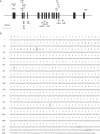Acidic α-galactosidase is the most abundant nectarin in floral nectar of common tobacco (Nicotiana tabacum)
- PMID: 22271925
- PMCID: PMC3286286
- DOI: 10.1093/aob/mcr321
Acidic α-galactosidase is the most abundant nectarin in floral nectar of common tobacco (Nicotiana tabacum)
Abstract
Background and aims: To date, most floral nectarins (nectar proteins) are reported to function in nectar defence, particularly for insect-pollinated outcrossing species. We compared nectarin composition and abundance in selfing common tobacco (Nicotiana tobaccum) with outcrossing ornamental tobacco plants to elucidate the functional difference of nectarins in different reproductive systems.
Methods: Common tobacco (CT) nectarins were separated by SDS-PAGE and the N terminus of the most abundant nectarin was sequenced via Edman degradation. The full-length nectarin gene was amplified and cloned from genomic DNA and mRNA with hiTail-PCR and RACE (rapid amplification of cDNA ends), and expression patterns were then investigated in different tissues using semi-quantitative reverse transcriptase PCR. Additionally, high-performance liquid chromatography and enzymatic analyses of nectar sugar composition, and other biochemical traits and functions of the novel nectarin were studied.
Key results: The most abundant nectarin in CT nectar is an acidic α-galactosidase, here designated NTα-Gal. This compound has a molecular mass of 40 013 Da and a theoretical pI of 5·33. NTα-Gal has a conserved α-Gal characteristic signature, encodes a mature protein of 364 amino acids and is expressed in different organs. Compared with 27 other melliferous plant species from different families, CT floral nectar demonstrated the highest α-Gal activity, which is inhibited by d-galactose. Raffinose family oligosaccharides were not detected in CT nectar, indicating that NTα-Gal does not function in post-secretory hydrolysis. Moreover, tobacco plant fruits did not develop intact skin with galactose inhibition of NTα-Gal activity in nectar, suggesting that NTα-Gal induces cell-wall surface restructuring during the initial stages of fruit development.
Conclusions: α-Gal was the most abundant nectarin in selfing CT plants, but was not detected in the nectar of strictly outcrossing sister tobacco species. No function was demonstrated in antimicrobial defence. Therefore, floral nectarins in selfing species maintain their functional significance in reproductive organ development.
Figures






Similar articles
-
Proteomics and post-secretory content adjustment of Nicotiana tabacum nectar.Planta. 2019 Nov;250(5):1703-1715. doi: 10.1007/s00425-019-03258-4. Epub 2019 Aug 14. Planta. 2019. PMID: 31414205
-
Nectarin I is a novel, soluble germin-like protein expressed in the nectar of Nicotiana sp.Plant Mol Biol. 1999 Sep;41(2):207-16. doi: 10.1023/a:1006363508648. Plant Mol Biol. 1999. PMID: 10579488
-
Floral nectar of the obligate outcrossing Canavalia gladiata (Jacq.) DC. (Fabaceae) contains only one predominant protein, a class III acidic chitinase.Plant Biol (Stuttg). 2017 Sep;19(5):749-759. doi: 10.1111/plb.12583. Epub 2017 Jun 26. Plant Biol (Stuttg). 2017. PMID: 28544154
-
Tobacco nectarin V is a flavin-containing berberine bridge enzyme-like protein with glucose oxidase activity.Plant Physiol. 2004 Jan;134(1):460-9. doi: 10.1104/pp.103.027482. Plant Physiol. 2004. PMID: 14730073 Free PMC article.
-
Protein and alkaloid patterns of the floral nectar in some solanaceous species.Acta Biol Hung. 2015 Sep;66(3):304-15. doi: 10.1556/018.66.2015.3.6. Acta Biol Hung. 2015. PMID: 26344026
Cited by
-
Proteomics and post-secretory content adjustment of Nicotiana tabacum nectar.Planta. 2019 Nov;250(5):1703-1715. doi: 10.1007/s00425-019-03258-4. Epub 2019 Aug 14. Planta. 2019. PMID: 31414205
-
MS-desi, a desiccation-related protein in the floral nectar of the evergreen velvet bean (Mucuna sempervirens Hemsl): molecular identification and characterization.Planta. 2013 Jul;238(1):77-89. doi: 10.1007/s00425-013-1876-2. Epub 2013 Apr 9. Planta. 2013. PMID: 23568404
-
Sex-Dependent Variation of Pumpkin (Cucurbita maxima cv. Big Max) Nectar and Nectaries as Determined by Proteomics and Metabolomics.Front Plant Sci. 2018 Jun 29;9:860. doi: 10.3389/fpls.2018.00860. eCollection 2018. Front Plant Sci. 2018. PMID: 30008725 Free PMC article.
-
Characterization of a L-Gulono-1,4-Lactone Oxidase Like Protein in the Floral Nectar of Mucuna sempervirens, Fabaceae.Front Plant Sci. 2018 Jul 30;9:1109. doi: 10.3389/fpls.2018.01109. eCollection 2018. Front Plant Sci. 2018. PMID: 30105046 Free PMC article.
-
Floral Nectary Morphology and Proteomic Analysis of Nectar of Liriodendron tulipifera Linn.Front Plant Sci. 2016 Jun 14;7:826. doi: 10.3389/fpls.2016.00826. eCollection 2016. Front Plant Sci. 2016. PMID: 27379122 Free PMC article.
References
-
- Baker HG, Baker I. A brief historical review of the chemistry of floral nectar. In: Bentley B, Elias T, editors. The biology of nectaries. New York: Columbia University Press; 1983. pp. 126–152.
-
- Bewley JD. Breaking down the walls – a role for endo-beta-mannanase in release from seed dormancy? Trends in Plant Science. 1997;2:464–469.
-
- Blöchl A, Peterbauer T, Hofmann J, et al. Enzymatic breakdown of raffinose oligosaccharides in pea seeds. Planta. 2008;228:99–110. - PubMed
Publication types
MeSH terms
Substances
LinkOut - more resources
Full Text Sources
Research Materials
Miscellaneous

